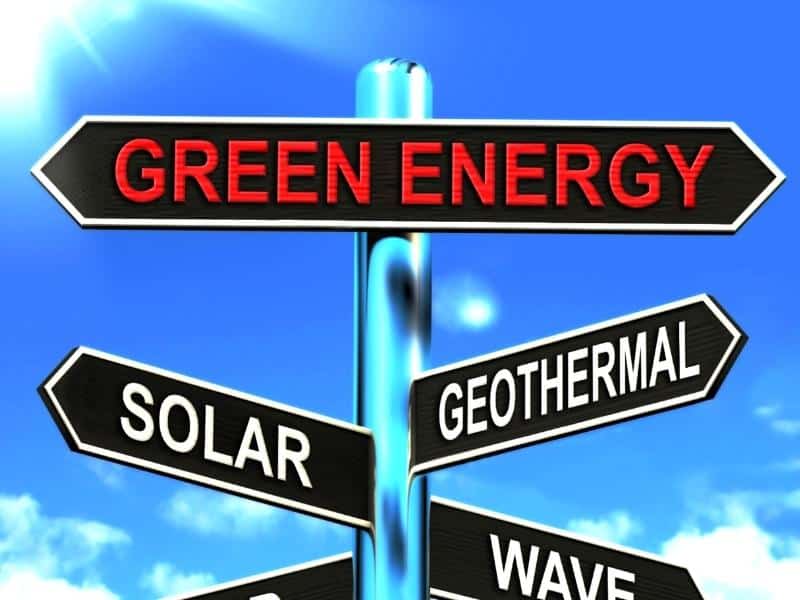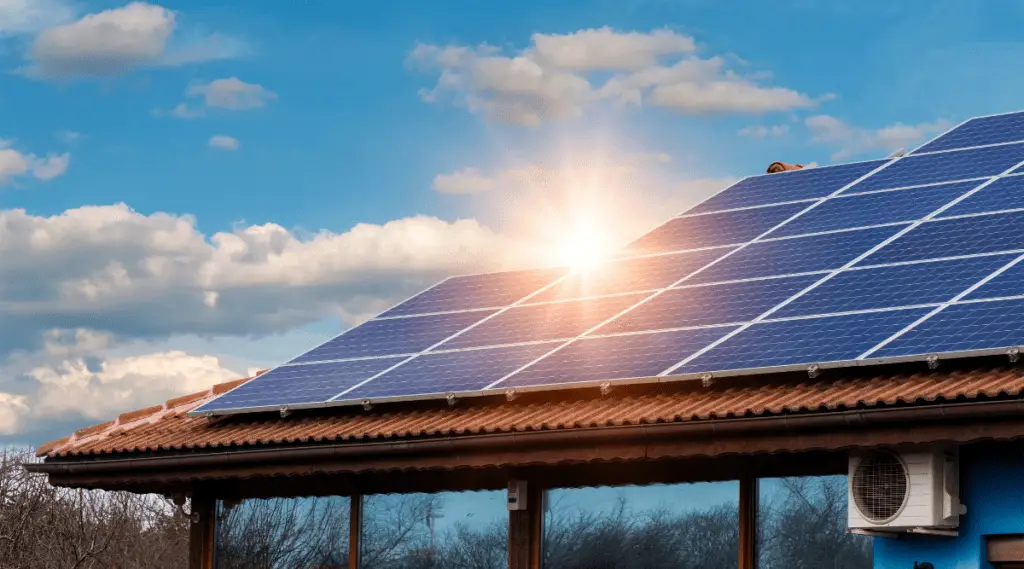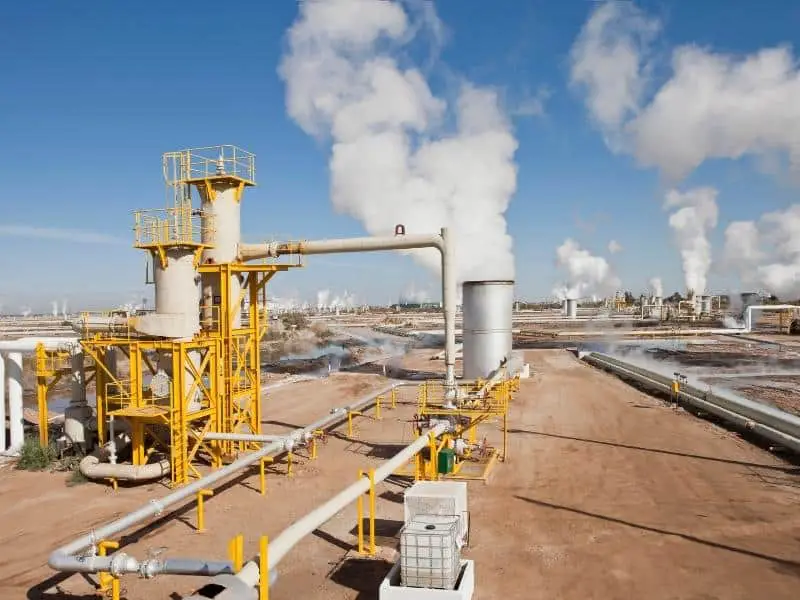Hydro, solar, and wind-powered energies have seen some important developments in the last few decades; however, another renewable source, geothermal energy, works on a completely different process from the other types. But how well does geothermal hold up against the more popular solar energy? Below we look at solar vs. geothermal energy.
As two sources of renewable energy, this article compares solar and geothermal energy by looking at:
- What they are and where they come from
- How they are harvested and their uses
- Their sustainability, efficacy, benefits, and drawbacks as sources of energy
- Their potential to replace fossil fuels
Renewable energies, like solar and geothermal, are the way of the future; but how do these energy sources differ? How are they harnessed, what uses do they have, and which one should lead us into a brighter, greener future?

How Do Solar And Geothermal Energy Compare As Green Energy?
To accurately compare these two energy sources, we need to have a general understanding of what the energy source is, how it works, what it’s used for, and the overall effectiveness.
Below, solar and geothermal energy’s characteristics are compared against each other to understand both energy sources better individually and against each other.
Briefly put, solar power is when the energy supplied by the sun, in the form of solar radiation, is caught and converted to electricity, or when the solar radiation is used to heat water or other substances.
Geothermal energy is heat released from the earth, used to heat water and structures, or converted into electricity.

Where Does Solar Energy Come From?
Solar energy comes from the sun.
The sun is a star that produces around 3.86 x 1026 watts of energy every second through nuclear fusion. Around 1.74 x 1017 watts of this energy reach the earth in long and short-wave radiation.
This solar energy drives all the earth’s processes (weather, nutrient cycling, primary production, etc.), and life on earth would cease to exist without it. Even though the earth requires this energy, not all of it is used up.
Solar power taps into this almost unlimited energy source and harnesses it to produce electricity and heat.
Where Does Geothermal Energy Come From?
Geothermal energy is energy produced and emitted by the earth as heat. Heat is released from the earth continuously. Understanding how the earth is structured is important to understand how this heat is produced.
The inner core is made of iron, which is solid and estimated at 1 500 miles in diameter and reaches a temperature of around 10 8000F, which is around the same temperature as the sun’s surface.
Magma (melted rock) comprises the outer core and is approximately 1 500 miles thick.
The next layer is around 1 800 miles thick, called the mantle, and comprises magma and solid rock pieces. This zone ranges in temperature from 3920F at the start of the earth’s crust to roughly 7 2300F by the outer core.

The Earth’s Crust
Finally, the crust is the outermost surface of the earth. The crust comprises tectonic plates roughly 15 to 35 miles thick(under the landmass and three to five miles under the ocean).
The heat from below the crust converges at the gaps between these plates and usually exits the crust through volcanoes or geothermal vents (among other ways).
This escaping thermal energy heats water and rock closest to the sources.
The heat within the earth is constantly replenished through radioactive decay. Simply put, radioactive elements are unstable elements and release energy and subatomic matter (particles).
These naturally unstable elements (they cannot remain in their current form) release all their energy or “decay” into a more stable form by shedding particles and electromagnetic energy.
This released heat is what we receive as geothermal energy, and it is released at a rate of approximately 30 terawatts (30 x 1012). This energy should continue for billions of years to come.
How Is Solar Energy Harvested And Harnessed?
Solar energy is harnessed directly through heat or creating electricity, depending on the required use.
Solar energy is harnessed through solar panels and photovoltaic glass if electricity production is required. Solar panels contain photovoltaic cells. These cells absorb the sun’s radiation and create a current.
Many of these cells working together in a solar panel create a large enough current to send to an inverter. This inverter changes the current from direct current into alternating current.
From this point, the current will either move to a battery bank to be stored or moved to supply the load (whatever needs the electricity).
If thermal energy is required to heat water or create electricity later, the process is slightly different.
Solar thermal energy is often concentrated using mirrors and reflectors, focusing the radiation on heating oil or molten salts. These heat-storing items are later used to heat water to produce steam and power turbines to generate electricity. The benefit of this is that stored solar energy is now used at night.
Solar geysers operate on a similar principle. Water is heated either directly through exposure to the sun’s energy or coils containing a heating fluid. The water, once heated, is held in an insulated container for later use.
How Is Geothermal Energy Harvested And Harnessed?
The method for harvesting geothermal energy involves drilling into the earth and using heated water to turn steam turbines or heat sources.
There are four methods of extracting geothermal energy from the earth. These include:
- Conventional hydrothermal resources: Thermal energy from the mantle heats underground water sources (in the crust). This heated water rises through porous rocks until it is trapped by solid rock. To access this hydrothermal source, companies drill down until a suitable reservoir (temperature) is discovered.
The hot water in this reservoir is channeled up to a plant(via a well), where the heat is used to power machinery. The water is pumped back, once cooled, into the reservoir to be reheated and balance the pressure.
- Enhanced geothermal systems (EGS): Thermal energy that is not conveniently located at a convergence point of heat, water, and porous rocks(as with conventional resources) can be acquired by creating wells to heat water. By drilling pathways and fracturing cavities (with highly pressurized water) for water to be pumped into and then extracted from, companies can manufacture hydrothermal energy from heated rocks void of naturally occurring water.
These geothermal sources are relatively deep below the surface and require more resources.
- Super-hot-rock geothermal: As the name implies, this method deals with extremely hot rocks located at vast depths. During this process, water becomes so heated and pressurized that it enters a new state known as “supercritical.” While in this state, water carries greater amounts of energy and converts that energy into around ten times the amount of electricity produced.
- Advanced geothermal systems (AGS): This is fundamentally a large radiator. The water used in this closed system to conduct heat is “trapped” within a pipe system that circulates between the hot rocks and the plant, where the heat is transferred. No water is added or removed from the natural environment, and no invasive fracking is required.
Due to the design, the hot water rises, while the cold waterfalls back down without a pump.
What Are Solar’s Uses, Sustainability, And Efficacy?
Although solar energy has many potential uses, the two primary usages of solar energy are electricity production and thermal energy.
- Electricity production. The most beneficial use, solar energy, allows electricity to be produced in an individual’s home.
- Thermal energy.The heating of water for solar geysers and oil or molten salts to store solar energy for future use (heating and electricity).
Solar power is derived from the sun’s energy. The amount of sunlight daily reaching the earth is around 200 000 times the daily energy requirements. We will not be able to use up all the sun’s energy anytime soon. It is, therefore, a highly sustainable resource.
In terms of its efficacy, solar power hits a big snag. Current technology means that solar power, although viable, is not as efficient and effective in providing dependable electricity on a large scale.
Even on a small-scale solar power has limitations. If you do not install a battery bank, you will have no electricity at night. Most solar energy cannot be fully harnessed yet, either.
In many places, the weather is another limiting factor, i.e., the amount of sunlight striking a solar panel influences the amount of power directly produced.
What Is Geothermal’s Use, Sustainability, And Efficacy?
Geothermal energy heats water and rocks, used directly as a heat source or to produce electricity.
- Heating through the naturally occurring “vents.” Fumaroles (steam vents associated with seismic activity), geysers, and hot springs are the most frequently used sources. Most of these produce hot water for bathing, cooking, or washing.
Geothermal energy nodes can also be used to heat building/structures.
- Electricity Production: Using hydrothermal power from superheated water to power turbines that create electricity.
In terms of sustainability, geothermal energy comes from the earth’s natural processes. It is estimated that the earth will continue to produce this energy for billions of years, making it a sustainable energy source.
The efficacy of geothermal power is currently limited by the technology available. Most plants are established at points where heat is visibly escaping the earth. If the intended advancements are made, however, geothermal energy could be the most efficient renewable energy source.
What Benefits Do Solar And Geothermal Power Have?
Both energies are clean, free, sustainable, renewable, and reduce the dependency on fossil fuels.
Solar Energy
- Solar energy is clean, and no harmful gasses are released during its production.
- The solar power source is the sun, which delivers the energy for free.
- Solar power can provide people who live too far away from the grid with electricity.
- Solar power saves on electricity costs, reduces the demand placed on the grid, and reduces the overall expenses a country faces by reducing import fees on fossil fuels.
- Most importantly, solar power is accessible to anyone as a private individual, which means you can live “off-the-grid.”
Geothermal Energy
- Potential for the cheapest baseload power with supercritical water.
- Geothermal energy is predictable, and it runs day and night, no matter the weather or season.
- With technological advances, the amount of electricity generated through geothermal energy can be increased or lowered as needed (through controlling the length of time water stays underground; you can increase its temperature, thereby increasing the energy output).
- During the process of “ramping down” the electricity supply, there is no wastage. The water does not disappear; it remains underground for longer.
- The earth produces geothermal energy naturally; it is sustainable, renewable, and clean.
- Geothermal energy could supplement other renewable energy sources or replace them in time.
What Drawbacks Do Solar And Geothermal Energy Have?
Both energies are expensive to set up, have certain negative elements in their harnessing and harvesting, and are not fully effective due to technological restrictions.
Solar Energy
- During the manufacturing process of components, pollution is produced. Additionally, harmful chemicals like cadmium are inside solar panels, and lead sulfide is in batteries.
- Solar energy, like most renewable energy sources, is temperamental. If the sun does not shine, if the wind does not blow, if there is a drought, then the energy supplied droops off. This unpredictable nature of green energy is a tremendous drawback because industry (and livelihoods in general) requires a fixed amount of power produced when and as needed.
- The start-up capital needed to set up a solar-powered system is relatively high to be viable.
- The disposal of old components is difficult and poses severe health risks for humans and animals if done incorrectly.
Geothermal Energy
- Most sources of geothermal energy are difficult to locate. Vents, hot springs, and geysers are clear indicators but limit the overall number of points. Explorative drilling is expensive, impractical, and environmentally unsound.
- The process of digging with pressurized water is known as “fracking,” a highly controversial practice from an environmental level. Although not entirely the same process as gas and oil fracking, there is still a lot of heated debate about blasting through rock with water.
- Technology is currently the biggest setback for geothermal energy. Many developments need to be made for this energy to operate close to its potential. These limitations include drilling techniques, equipment that needs to resist extreme temperatures and pressure, and cement for buildings and construction.
- Rocks located deeper and existing water bodies produce more heat but are exceedingly difficult in pumping water to and from (the cost is higher). Overall geothermal is more expensive than solar.
- Direct access to geothermal energy is limited to those who possess a source (e.g., hot spring) or companies with the capital, expertise, and equipment to harness it. It is not as readily available to everyone as solar is.
Which is Better Solar or Geothermal Power?
Currently, geothermal energy is in the shadows of solar power; however, solar power benefits the individual, while geothermal power could benefit the species (humans).
For geothermal to become a competitive option against “traditional” renewable energy sources, the technology and techniques need to improve, which the evidence would suggest is in the process.
Funding and widespread buy-in are two critical factors that have limited geothermal energy developments up until recently. The renewed vigor companies are expending on geothermal energy may soon take the top spot in renewable sources. Hopefully, one day soon, geothermal energy will overtake fossil fuels as the primary energy source we humans use.
Although geothermal energy is costlier than solar, the future pay-off will be greater.
Solar power, although not perfect, is a fantastic transitional energy source. Its greatest limitation is the weather dependency on solar power. Another big negative factor is the cost of setting up a solar-powered system.
The only way to truly move forward is through a combination of different renewable energy sources, each complimenting one another.
Sources:
- https://www.eia.gov/energyexplained/geothermal/#
- https://whatis.techtarget.com/definition/solar-power
- https://www.vox.com/energy-and-environment/2020/10/21/21515461/renewable-energy-geothermal-egs-ags-supercritical
- https://www.britannica.com/science/radioactivity
- https://news.energysage.com/how-solar-photovoltaic-cells-work/
- https://www.energy.gov/eere/solar/how-does-solar-work
- https://www.energystar.gov/products/water_heaters/water_heater_solar/how_it_works
- https://www.britannica.com/science/solar-energy



